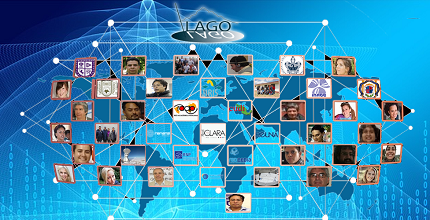 The data generated between the different LAGO centers are transferred through the Advanced Networks. Depending on the number of detectors, 5 to 10 GB are processed monthly for each site, as indicated by Dr. Torres, principal investigator of the project.
The data generated between the different LAGO centers are transferred through the Advanced Networks. Depending on the number of detectors, 5 to 10 GB are processed monthly for each site, as indicated by Dr. Torres, principal investigator of the project.
The Latin American Giant Observatory (LAGO), is an international project of astrophysics and astroparticles involving 9 countries of Latin America located at different altitudes from Mexico to Antarctica, namely Argentina, Brazil, Chile, Colombia, Ecuador, Spain, Guatemala, Mexico and Peru. It is integrated by interdisciplinary groups of physicists, engineers and students with almost 100 members from 25 academic institutions. It was founded in 2005 during a meeting held in San Carlos de Bariloche, following its proposal at RICH2004 in Mexico.
Five member institutions of the Mexican National Network of Education and Research, CUDI, participate at LAGO,
- Universidad Autónoma de Chiapas(UNACH)
- Instituto Nacional de Astrofísica, Óptica y Electrónica (INAOE)
- Benemérita Universidad Autónoma de Puebla (BUAP)
- Universidad Politécnica de Pachuca (UPP)
- Universidad Michoacana de San Nicolás de Hidalgo (UMSNH)
The project consists of operating low cost Cherenkov detectors in water, in the high mountains, to detect gamma ray flashes and study transient and long-term space weather phenomena through the solar modulation of cosmic rays. The first detector was built in Bariloche in 2005, and the first in height was assembled in Chacaltaya, Bolivia, in 2006.
The electronics of LAGO in 2005 consisted of an adaptation of the electronic prototype of the Pierre Auger Observatory. Thanks to a grant from ICTP (International Center for Theoretical Physics) in 2010, it was decided to develop a new infrastructure exclusively for LAGO. This development was mainly done in the DPR laboratory (Detection of Particles and Radiation of the Bariloche Atomic Center), in collaboration with the group of Puebla, Mexico. It was distributed in the different LAGO sites and began to be used in December 2011.
The LAGO collaboration is committed to education and scientific dissemination in each of the participating regions. Among the tasks of the members and their institutions is to train Latin American students in astroparticle physics and build a Latin American astroparticle research network. Part of the philosophy of collaboration is to maintain free access to knowledge and data of its scientific production. Consequently, LAGO is one of the few projects in the region that has a repository of experimental data and simulations.
"Almost all the detectors belonging to the LAGO project are installed in remote and inaccessible areas, so the use of the internet facilitates the collection of data and the health tests of each detector. Before installing each detector, computational simulations should be performed to give us some idea of the parameters we expect or to establish the design of the detectors. For this we must simulate the arrival of different particles, with different energies and different directions of arrival, simulate the physical processes to which each of these waterfalls are subjected during their development within the atmosphere, the secondary particles produced by each waterfall – some of it with hundreds of millions of individual particles. Then, each of these particles is injected into a Monte Carlo simulation code that results in the performance of each detector subjected to this radiation.
“Due to the large number of calculations of both simulations, the use of computer clusters is now required, a simulation of this type can last a few months in a good sized Cluster". This was indicated by Dr. Ibrahim Torres at the First Latin American Meeting of eScience, held in San José, Costa Rica, from July 3 to 5, 2017. Dr. Torres is the Principal Researcher of the LAGO Project, a researcher at the National Institute of Astrophysics, Optics and Electronics (INAOE). His first participation in the LAGO project began when he made his first postdoc at the Benemerita Autonomous University of Puebla (BUAP) in 2006 and was responsible for going to Sierra Negra for the data.
"The members of this project belong to a large number of universities around Latin America, so in order to concentrate efforts efficiently, we have used new technologies mainly based on the internet to hold frequent meetings held through video conferences.
“The software used to analyze all the data collected by each detector is developed by several project members; in previous decades each researcher was responsible for the programming of their software. However, with the amount of data that has to be processed, it is no longer viable for a single researcher to generate such a quantity of code and this has led us to explore ICT based in collaborative work that allows us to work remotely and independently, but without destructive interference with our colleagues", says Dr. Torres. “RedCLARA has provided us with its platform and now we are able to hold periodic videoconferences for collaboration, no longer needing a sophisticated equipment to be able to connect ".
"The LAGO observatory has been operating for some years, collecting data on the detection of gamma and cosmic rays. During these years we registered some phenomena of space weather as the so-called forbush decrease, which is a decrease in the cup of arrival of cosmic rays due to the coronal mass ejections of our Sun. We do not rule out recording the first event of gamma-ray bursts, synchronizing our detections with those of any of the satellites such as Fermi or Swift. During the life of this project, a couple of dozen students from undergraduate to doctorate contributed to the training of highly trained human resources in Latin America.”
“The use of academic networks is vital for collaboration in LAGO. Without them we would have to pay companies to provide the same service", said Dr. Torres.
As a competitive initiative developed from Latin America, which takes full advantage of the geographical conditions and the tradition of several groups in high mountain work, Humberto Salazar Ibargüen, responsible for the LAGO site in Sierra Negra, mentioned in an interview for RedCLARA that: "The reduced cost of the experiment, and the formation of human resources, both in the technological and scientific area, are aspects that highlight this competitiveness".
"The data generated between the different LAGO centers are transferred through the Advanced Networks. Depending on the number of detectors, 5 to 10 GB are processed monthly for each site. LAGO has published its results in refereed international scientific journals and presented its advances at the ICRC (International Cosmic Rays Conference) in Busan, Korea. It has also been a great driver in the formation of high quality human resources in the area of high energy astrophysics. Keeping in touch with colleagues and students, often co-advised by colleagues from another country, is one of the technical problems that we have solved with the help of the National Networks of Research and Education members of RedCLARA", Dr. Torres concludes.
For 2018, LAGO is looking to have the new electronics for the acquisition of data, a new detector will be installed in Viña del Mar, Chile, and the incorporation of Cuba to the Project is sought.
________________________________________
References:
https://documentos.redclara.net/bitstream/10786/1314/1/Proyecto%20internacional%20LAGO.pdf
http://lagoproject.org/
http://dspace.redclara.net/bitstream/10786/464/1/alice2_cs03_lago_es.pdf
http://cevale2.uis.edu.co/~cevale2/wiki/index.php/P%C3%A1gina_Principal
https://es.slideshare.net/rodrigotorrens/repositorio-de-datos-lago





